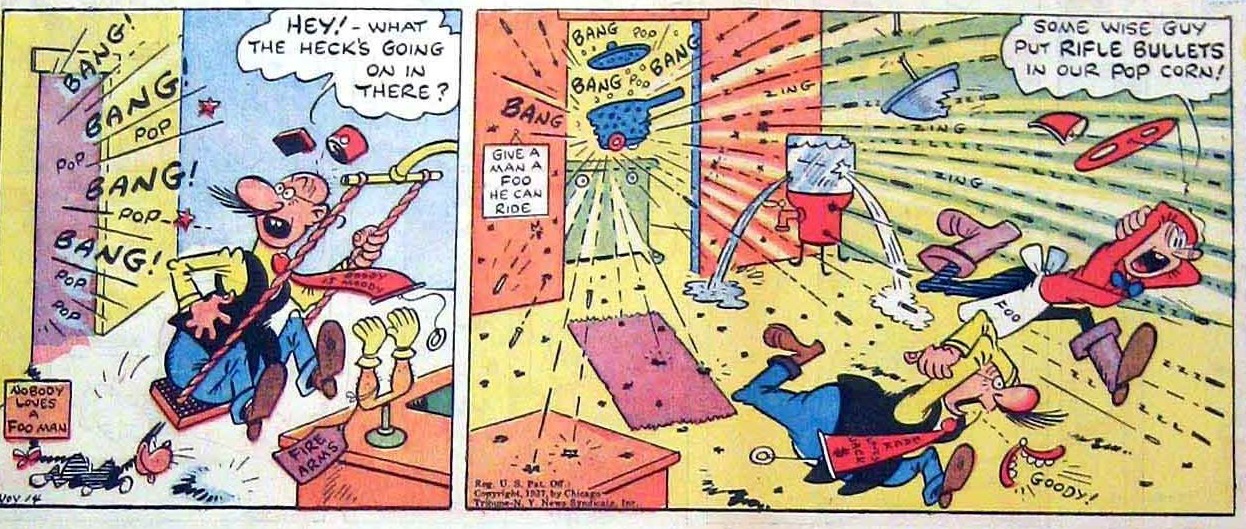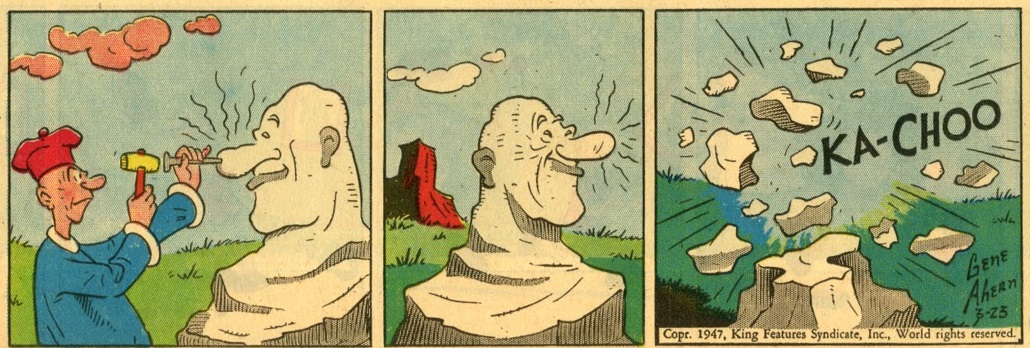Out into the world to see Who’s Who and What’s Not
-Count Screwloose
In baseball parlance, a “screwball” is the opposite of a “straight pitch”, that is, a trick play, an unforeseen or erratic tactic. The screwy, at its most basic, is a form of energy, something simultaneously marvellous, explosive, and, as a consequence of its unexpected penchant for mess-making, ridiculously funny. “founded”, as comic historian Paul Tumey says, “on the joyful liberation of nonsense”. There’s been a strong affinity for the unhinged magic of screwball that goes back to the roots of the surrealist movement, particularly in relation to films (Marx Bros., Hellzapoppin’, W.C. Fields) and the more manic spectrum of animated cartoons. But it was Franklin Rosemont who in his many articles on comics and other “Popular Accomplices”, first made the explicit link between surrealism and the american cartoonists that comprise the screwball genre proper: Milt Gross, George Herriman, Winsor McCay, Rube Goldberg etc.,

Unfortunately, the vast majority of these comics were for many years mostly out of print, or only found in rare, large and disintegrated newspaper formats, liable to fall apart at the slightest guffaw. This fact, as well as the lack of information on this period of comic history in general, has meant that the surrealist appreciation of this era has only been by necessity a cursory one.
So it’s with great pleasure that we take note a new book, published in October 2019 by the comics historian Paul Tumey that focuses exclusively on screwball comics. In addition, his screwball comics blog is a goldmine of information, analysis, and salvaged strips.
SCREWBALL! The Cartoonists Who Made the Funnies Funny
Focusing on the early to mid 20th century newspaper “funnies”, Tumey’s research has unearthed quite a few once-famous, now forgotten gems in the screwballverse. In particular we note the “Squirrel Cage” comics of Gene Ahern, which in the 1940s take a genuinely surrealist turn with the introduction of the “Foozland” arc, a genuine surrealist geography, and its demented denizens, including the infamously strange gnome-like hitchhiker whose nonsensical catchphrase is “Nov schmoz ka pop?”
And there are other wonderful rehabilitations too, such as Fred Opper, Bill Holman, E.C. Segar, or Gus Mager, (whose Knocko the Monk comics helped give the Marx Bros. their stage names). It also includes a more in-depth look at the extended corpus of surrealist favourites like Milt Gross and Rube Goldberg (beyond the machines). It’s simple enough to see the connection between a Rube Goldberg machine and a machine portrait by Picabia. But there is also a less well-known current of his dark humor. For example, the early period of Boob McNutt comics, where due to an amorous longing he eponymous hero is constantly trying to kill himself using the same type of multistep screwball mechanics.

From the “Ark” offshoot of Boob McNutt, by Rube Goldberg
Over and above indiscriminate archival diving, Tumey is working on establishing a retroactive “canon” of screwballism, and even an accompanying theoretical language to describe its praxis. For example, his blog post on Energy Patterns Observed in a 1927 Screwball Salesman Sam Sunday by George Swan provides a very compelling directional theory for the phenomenon of the comic explosion so essential to screwball comedy. Maybe something almost approaching a surrealist physics or surrealist theory of motion. As Tumey says. “It’s all about conflict and comically explosive resolution.”
Some of the very interesting categories of screwballism that emerge in Tumey’s research include:
Escalation – “This refers… to the build-up of a seemingly trivial event, such as tying a necktie, or making a squeak toy squeak into a visual opera of human madness…As we are discovering, screwballism arises in large part as a reaction to the sudden acceleration of technological innovation that occurs in the early 20th century…Rube Goldberg, especially with his chain-reaction invention cartoons, is probably the prime exponent of this theme in America, in all mediums, not just comics.” – Paul Tumey
Oversaturation – The cramming full or overcomplication of a situation. Often including non-essential or extra gags. Especially in the case of Bill Holman (who called them “wallnuts”) and Will Elder (who called them “chicken fat”)
Banana Oil – the ludicrous joy of calling out bullshit in a way that explodes the pretensions of puffed up people.
And many other hilarious labels for this most singular form of erratic potential. The implications for surrealism, as it continues to manifest itself as opposed to the new flavours of banana oil in the 21st century, remains deliciously poignant. And reading Tumey, ones gets the sense that there is even more to be rediscovered, on the other side of the funny papers.
-Jason Abdelhadi

Links:
SCREWBALL! The Cartoonists Who Made the Funnies Funny
A PDF of Franklin Rosemont et al, “Surrealism and its Popular Accomplices”
(Images borrowed from the above blogs)

